PROVIDENCE, R.I. [Brown University] — Brown University offered admission to 1,651 prospective members of next year’s entering undergraduate class on Thursday, March 31. Admitted through Brown’s regular decision process, the students join early decision applicants offered admission in December 2021 for a total admitted class of 2,546.
A total of 50,649 prospective students applied to attend Brown — a 9% increase from last year, and the University’s largest applicant pool to date by more than 4,000 students.
“Brown was tremendously fortunate to select its incoming class from an outstanding pool of impressive applicants, who bring a wide range of academic and personal experiences and accomplishments,” said Dean of Admission Logan Powell. “The intellectual vitality, optimistic spirit and commitment to community engagement represented in these Class of 2026 admitted students will be a wonderful addition to the University.”
The prominent public leadership of Brown scholars in confronting the most challenging issues facing the world contributed to this year’s increase in applications, Powell said. In addition to the role of faculty in addressing the COVID-19 pandemic, Brown scholars have been at the forefront of research and public engagement in areas such as climate change, economic mobility and brain science.
The University has also responded to the unrest and instability around the world with offers of admission and additional support to students from both Afghanistan and Ukraine. Brown was one of the first American universities to bring to campus displaced Afghan students this fall, and this spring shared advanced likelihood of admission and availability of additional resources with a group of prospective students from Ukraine.
“I am incredibly proud of the way we have been able to step forward as a community to support these outstanding students who are facing incredibly difficult circumstances,” Powell said. “There is an urgency to this moment, and Brown is taking immediate action to provide assistance to talented students who have been displaced from their homes.”
